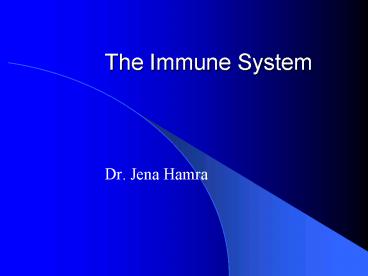The Immune System - PowerPoint PPT Presentation
1 / 29
Title:
The Immune System
Description:
Release histamine, heparin. Neutrophils. Ingest and digest ... Histamine. Located in granules of mast cells and basophils. Initiates inflammatory response ... – PowerPoint PPT presentation
Number of Views:76
Avg rating:3.0/5.0
Title: The Immune System
1
The Immune System
- Dr. Jena Hamra
2
Immune System
- 3 major functions
- Protects body from disease
- Bacteria, viruses, fungi, parasites
- ANTIGEN Anything that causes immune response
- Remove dead or damaged tissue
- Recognizes and removes abnormal cells
- 2 types of immune responses
- Innate immunity
- Nonspecific, immediate
- Acquired immunity
- Specific, can take several days
3
Anatomy of the Immune System
- Lymphoid tissues
- Primary
- Bone marrow
- Thymus gland
- Secondary
- Spleen
- Lymph nodes
- Diffuse tissues
- Tonsils
- GALT
4
(No Transcript)
5
Cells of the Immune System
- Leukocytes
- Eosinophils
- Basophils/Mast cells
- Neutrophils
- Monocytes/Macrophages
- Lymphocytes
- Dendritic cells
6
Cell Function
- GRANULOCYTES
- Eosinophils
- Fight parasites
- Allergic reactions
- Basophils
- Release histamine, heparin
- Neutrophils
- Ingest and digest bacteria
- Most abundant WBC in blood
- Release pyrogens, mediators of inflammation
7
Cell Function
- Lymphocytes
- Secrete antibodies
- Memory cells
- Cytotoxic cells
- Monocytes
- Macrophages in tissue
- Primary scavengers
- Bacteria, tissue
- Antigen presenting cells
- Dendritic cells
- Recognize, capture antigen
- Antigen presenting cells
8
(No Transcript)
9
Innate Immunity
- Nonspecific response
- Physical barriers
- Skin
- Mucous membranes
- Ciliated epithelium
- Phagocytes
- Macrophages and neutrophils
- Phagocytosis
- Receptor mediated
- Extravasation and diapedesis
10
(No Transcript)
11
Chemical Mediators
- Inflammation
- Cytokines from macrophages
- Chemotaxis
- Increase capillary permeability
- Fever
- Acute phase proteins
- Produced by liver
- Released early in immune response
- Opsonins, antiprotease
12
Chemical Mediators
- Histamine
- Located in granules of mast cells and basophils
- Initiates inflammatory response
- Increase capillary permeability
- Edema
- Vasodilation
- Increased local blood flow
- Interleukins
- Interleukin-1
- Secreted by activated macrophages
- Increase capillary permeability
- Stimulates acute phase protein synthesis
- Induces fever
- Stimulates cytokine release
13
Chemical Mediators
- Bradykinin
- Vasodilator
- Stimulates pain receptors
- Complement proteins
- Cascade
- Formation of membrane attack complex
- Lipid soluble molecules
- Insert into pathogen membrane, form pores
- Cell lysis
14
(No Transcript)
15
Acquired Immunity
- Selective reaction to a specific antigen
- Mediated by lymphocytes
- Membrane receptors specific for particular ligand
- Same specificity clones
- Clonal expansion
- First exposure to antigen
- Cells divide new clones
- Produces effector cells and memory cells
- Second exposure to antigen
- Activation of memory cells
16
(No Transcript)
17
Lymphocyte Cytokines
- Required for activation and normal immune
response - Interleukins
- Clonal expansion and differentiation
- Interferons
- Alpha and beta activate pathways against viral
infection - Gamma Activates macrophages
18
Lymphocyte Subtypes
- B lymphocytes
- Secrete antibodies
- T lymphocytes
- Helper T cells (CD4) Secrete cytokines required
for development of immune response - Cytotoxic T cells (CD8) Attack and destroy
foreign cells - Natural killer cells Attack and destroy virally
infected or cancer cells
19
Antibody Secretion (Humoral Immunity)
- B cells
- Activated B cells ? Plasma cells
- Plasma cells secrete antibodies
- Primary and secondary antibody response
- Primary Slower and and weaker
- IgM
- Secondary Faster, more antibodies produced
- IgG
20
(No Transcript)
21
Antibodies
- IgG
- 75, Secondary response
- IgM
- Primary antibody response
- IgA
- Secretory saliva, tears
- IgE
- Allergic responses
- IgD
- Cell surface receptor on B lymphocytes
22
Antibody Structure
- Y shaped proteins
- 2 heavy chains, 2 light chains
- Fab region antigen binding sites
23
Antibody Function
- Opsonins
- Coat antigens, facilitate phagocytosis
- Make antigens clump
- Activate other immune cells
- Cytotoxic T cells
- Phagocytic cells
- B lymphocytes
- Activate complement
- Activate mast cells
24
(No Transcript)
25
Cellular Immunity
- T lymphocytes
- Mature in thymus
- Require antigen presenting cells
- Cytotoxic T cells
- Helper T cells
- T cell receptor
- Required for recognition of antigen
- Major histocompatibility complexes
- Required for antigen presentation
- CD4 recognize MHC II
- CD8 recognize MHC I
26
(No Transcript)
27
(No Transcript)
28
(No Transcript)
29
(No Transcript)































